The Largest Building Projects in Africa: A Vision for the Future
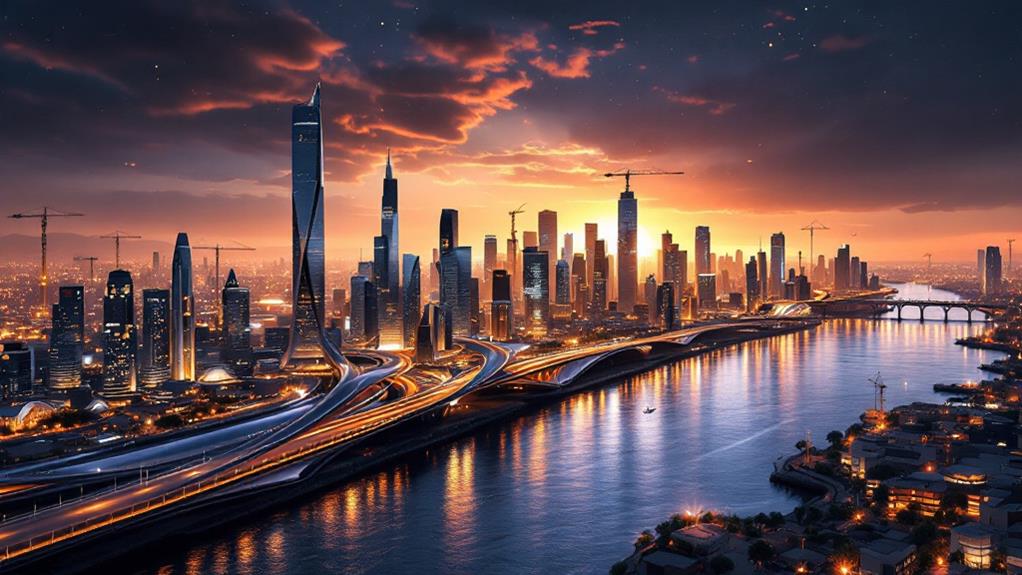
You're entering a crucial time in Africa as it undertakes massive building projects reshaping its future. Imagine Egypt's New Capital City easing urban congestion with room for 6.5 million residents, or Kenya's Konza City turning into a Silicon Valley-inspired tech hub. Picture the High-Speed Rail in Egypt cutting travel times and emissions. Think about the Dangote Oil Refinery setting a new standard for energy independence, and the Google Equiano Cable transforming digital connectivity. These projects, among others, form a vision of innovation and sustainable growth across the continent. More revelations come when you investigate the broader implications of these initiatives.
New Capital City of Egypt
The New Capital City of Egypt is set to spring up 45 km east of Cairo, taking on the challenge of alleviating the city's urban congestion. This ambitious project is designed to accommodate roughly 6.5 million residents, offering a modern solution to the overcrowding issues plaguing Cairo. By implementing state-of-the-art infrastructure, the new city promises to be a guiding light of economic development.
You'll find 25 commercial districts and 21 residential districts, each equipped with amenities like a theme park, technology park, and artificial lakes. These features aim to attract international investment while enhancing the quality of life for its inhabitants. The city's infrastructure plan includes 2,000 educational institutions, 1,250 mosques, and 663 clinics and hospitals, ensuring all-encompassing support for residents' educational and health needs.
With a projected transfer cost of $45 billion USD for government entities, the development is a significant financial undertaking. Yet, it's deemed crucial for fostering economic growth. The inclusion of a solar energy farm and a recreational park underscores a commitment to sustainability and well-being, making the New Capital City a forward-thinking urban center in Africa.
Eskom's Energy Transition
As Eskom initiates its energy shift expedition, the utility has secured $8.5 billion USD in grants and loans to pivot away from coal, aiming to fast-track new energy projects. This funding is a cornerstone in Eskom's ambitious plan to slash emissions by 2030, a crucial step since South Africa ranks as the 12th largest emitter of climate-warming gases. You'll find this transformation not only addresses environmental concerns but also aligns with South Africa's broader infrastructure initiatives, enhancing energy security and sustainability.
Eskom's commitment to a greener future is part of a larger picture. By targeting net-zero emissions by 2050, the utility is focusing on developing solar facilities at mining sites, a move that promises not only environmental benefits but also economic growth. These projects are expected to create jobs and stimulate local economies, fostering a more sustainable energy sector.
Moreover, Eskom's strategy is well-coordinated with regional energy initiatives, such as the NS GBC 225 kW Regional Interconnection Line. This project aims to elevate electrical connectivity across West Africa, showcasing a collaborative effort to address the continent's energy needs. Your support of such initiatives can contribute to a brighter, more sustainable future for Africa.
De Beers Diamond Ventures
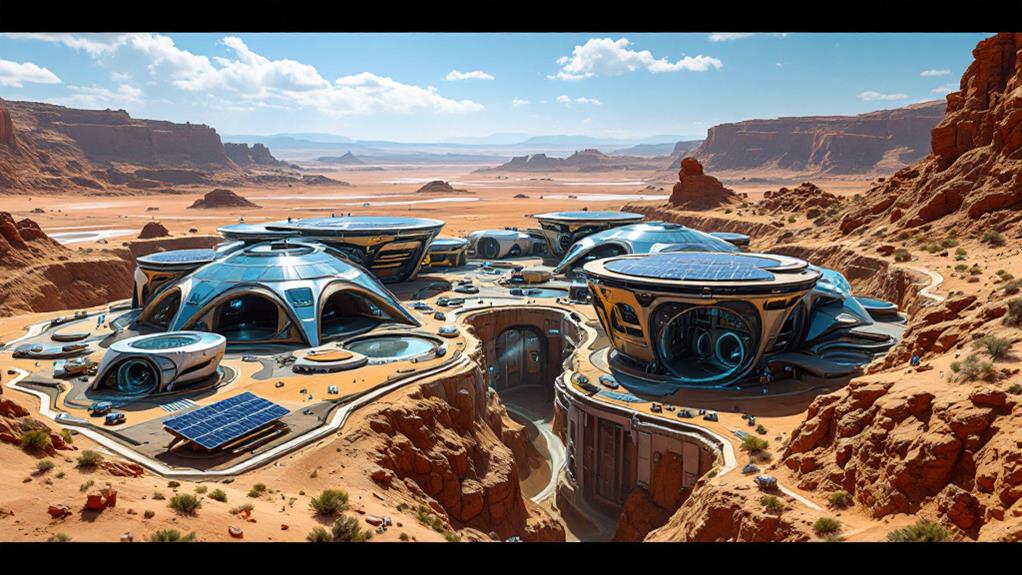
De Beers' diamond ventures play a crucial role in the economies of Namibia and Botswana, ensuring sustainable development and job creation. In Namibia, De Beers partners with the government through Namdeb, with operations now extended until 2042. This extension is a mega project that promises to generate an estimated $2.71 billion USD, markedly increasing the country's economy. In Botswana, Debswana, another joint venture, plans to invest $6 billion USD in developing the world's largest underground diamond mine. This ambitious project will improve the country's mining capabilities and further solidify its position in the diamond industry.
In 2020, the Jwaneng mine in Botswana produced an impressive 7.5 million carats, contributing considerably to De Beers' total diamond output. This output not only underscores the company's influence but also highlights the importance of its projects in driving economic progress and sustainability. De Beers' operations are akin to disaster recovery centers for these economies, ensuring resilience and stability even in challenging times. By focusing on such mega projects, De Beers continues to foster job creation and sustainable development, making a lasting impact on the communities in both Namibia and Botswana.
Kenya's Konza City
Innovation lies at the heart of Kenya's ambitious Konza Technology City, a $14.5 billion initiative set to transform the landscape 64 km from Nairobi. As you investigate this visionary project, you'll see it aims to emulate the success of Silicon Valley, setting a benchmark for technology cities worldwide. By fostering economic growth through technology and innovation, Konza City is poised to become a guiding light for local and international investors. It's not just about attracting businesses but also creating an ecosystem that thrives on business outsourcing, software development, and cutting-edge research.
Konza City is integral to Kenya's Vision 2030, which ambitiously seeks to position the nation as a knowledge-based economy. This development will feature modern infrastructure, including residential neighborhoods and educational institutions, all designed to support a burgeoning tech-savvy population. You'll find this technology city isn't just about infrastructure; it's about sparking economic growth by creating thousands of jobs and contributing notably to Kenya's GDP.
Imagine a place where innovation meets opportunity, and economic development isn't just a plan but a reality. Konza City promises to be a transformative force, spurring economic progress and elevating Kenya on the global stage.
Dangote Oil Refinery
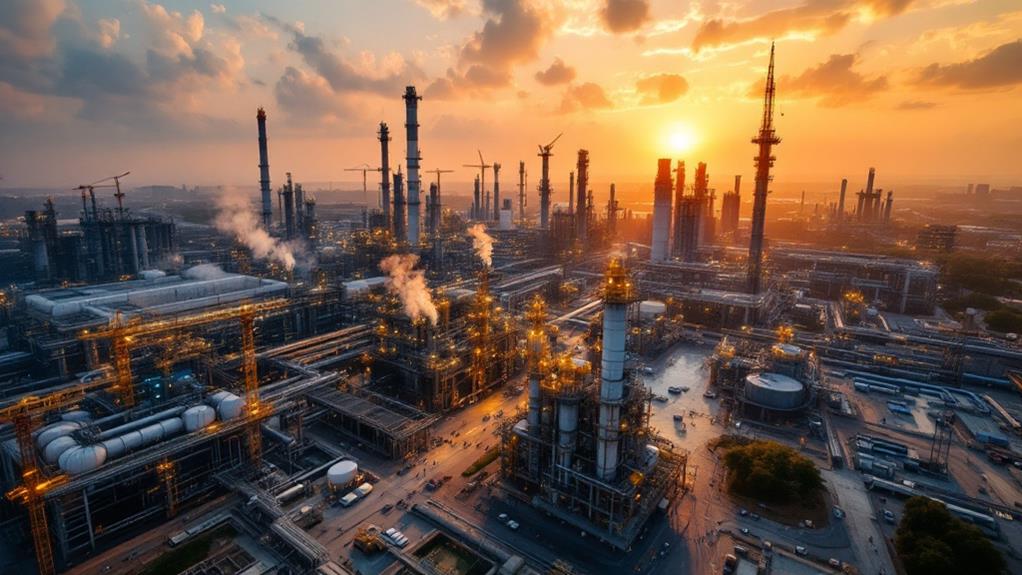
Amidst the vast landscape of Nigeria, the Dangote Oil Refinery stands as a monumental project set to redefine the country's energy sector. Projected to be Africa's largest oil refinery, it's a single-train facility with an impressive processing capacity of 650,000 barrels of crude oil per day. This ambitious infrastructure project is not just about size; it's about transforming Nigeria's place in the global energy market.
You've probably heard about its hefty $19 billion USD price tag, but consider what this investment means. The refinery aims to churn out 327,000 barrels of gasoline, 244,000 barrels of diesel, and 56,000 barrels of jet fuel daily, which could greatly reduce fuel shortages in the region. With the Nigerian National Petroleum Corporation (NNPC) acquiring a 20% stake, national ownership and investment are set to rise.
Constructed on a sprawling 2,635-hectare site, the Dangote Oil Refinery is more than an infrastructure project—it's a symbol of economic growth. By creating thousands of jobs, it's poised to enhance the economy and support Nigeria's energy independence, ensuring a brighter, more self-reliant future for the nation.
NS GBC Interconnection Line
Stretching across 1,677 km, the NS GBC Interconnection Line is transforming the landscape of electrical connectivity in West Africa. This ambitious project links Gambia, Guinea, and Senegal, ensuring that these countries benefit from a shared power exchange. By collaborating among national utilities, they've taken a significant step toward reducing dependence on fossil fuels and enhancing energy security.
Imagine being part of a region where access to reliable electricity was once a challenge. With the construction of 15 electrical transformation stations, the NS GBC Interconnection Line is making that a thing of the past. Thanks to this project, communities across these three nations are seeing the lights come on, literally and metaphorically. It's not just about keeping the lights on; it's about fostering economic development and sustainable growth.
This line plays a vital role in broader regional energy initiatives, focusing on sustainable development and increasing energy access for local populations. By ensuring a stable and consistent energy supply, it supports economic development, creating opportunities for businesses and improving living standards. As these countries work together, they're building a future where energy security isn't just a goal—it's a reality.
Lobito Corridor Upgrades
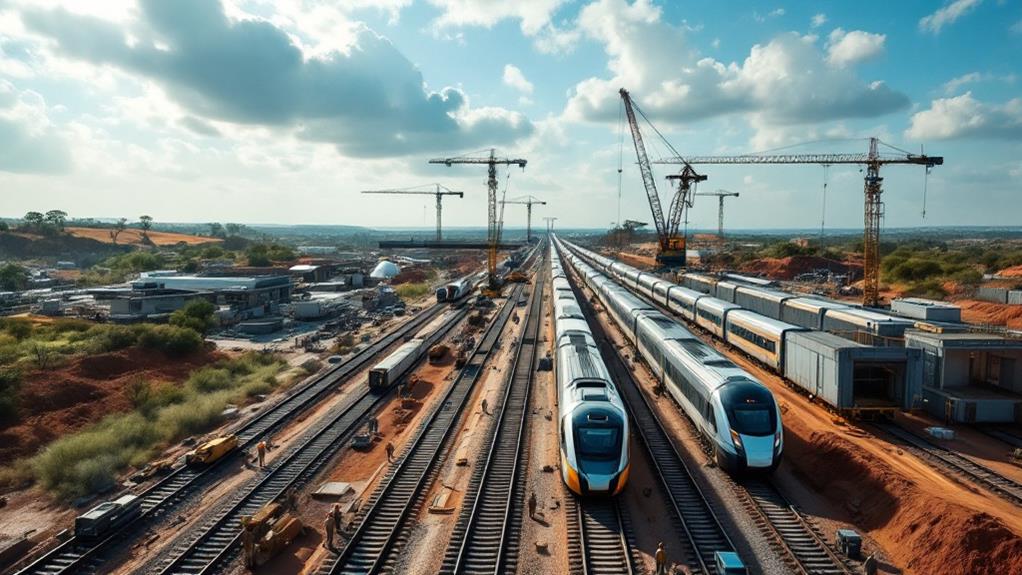
Through strategic investments and regional collaboration, the Lobito Corridor is transforming connectivity in southern Africa. By linking the Democratic Republic of Congo (DRC) and Zambia to global markets via the Lobito port in Angola, this project is a game-changer for economic growth in the region. You can imagine the impact of a $455 million investment dedicated to railway upgrades, streamlining logistics for the mining sector. This isn't just about tracks and trains; it's about creating a lifeline for landlocked countries that often struggle with high transportation costs and limited access to international markets.
Consider these points about the Lobito Corridor:
- It improves efficiency in transporting goods, cutting costs considerably.
- Promotes regional integration and cooperation among neighboring nations.
- Aligns with broader southern African infrastructure initiatives.
- Contributes to increased trade volumes and economic development.
These upgrades are more than just infrastructure improvements; they're a catalyst for regional economic collaboration. By facilitating easier and cheaper trade routes, the Lobito Corridor is a critical step towards fostering economic growth and creating new opportunities for businesses and communities across southern Africa. It's about building a future where borders don't hinder progress but instead, open doors to possibility.
High-Speed Rail in Egypt
Imagine a future where traveling across Egypt is not only faster but also more sustainable. This vision becomes reality with Egypt's ambitious high-speed rail project, a transformative leap in transportation infrastructure. Spanning 2,000 km, this network will redefine how you move between major cities, slashing travel times and enhancing connectivity. The project's core goal is to cut energy consumption and carbon emissions by an impressive 70%, aligning with Egypt's commitment to sustainability and environmental stewardship.
By connecting key urban centers, the high-speed rail system will spur economic growth and facilitate trade, enhancing regional connectivity. You'll find that it not only alleviates the notorious traffic congestion but also provides a safer, more reliable travel option for millions of passengers each year. This shift in transportation infrastructure will make daily commutes and long-distance travel more efficient, contributing to a more streamlined public transportation landscape.
Contracts for this monumental project underscore a strong commitment to modernize Egypt's transportation infrastructure. This initiative supports broader economic development goals, ensuring that Egypt remains a competitive and progressive hub in the region. Welcome a future where high-speed rail transforms how you experience Egypt.
Google Equiano Cable
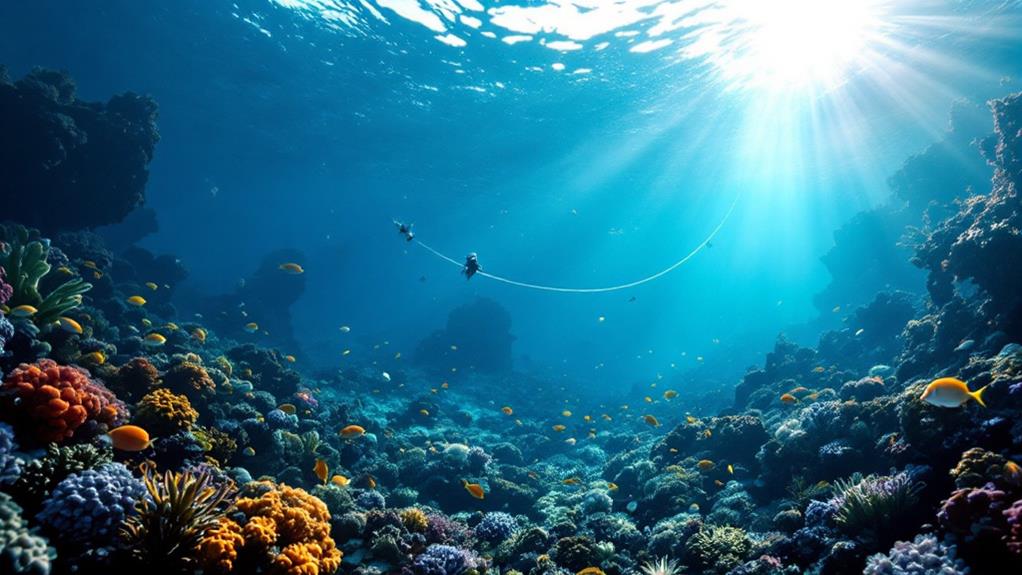
As Egypt takes strides in transforming its transportation landscape, another ambitious endeavor is underway beneath the waves of the Atlantic Ocean. The Google Equiano Cable is a groundbreaking 15,000 km submarine internet cable stretching from Portugal to South Africa. It's set to revolutionize internet connectivity along Africa's West Coast. Once completed in 2024, this cable will drastically lower data costs and is anticipated to quintuple internet speeds in certain regions, revealing unprecedented digital accessibility for millions.
Here's why you should be excited about the Google Equiano Cable:
- Enhanced Connectivity: Directly linking Africa to Europe, it paves the way for seamless digital communication.
- Economic Growth: By improving digital infrastructure, it fosters socio-economic development across the continent.
- Competitive Market: Google's commitment to share cable capacity with local ISPs promotes competition, leading to better services for consumers.
- Strategic Investment: Marks a shift towards significant digital infrastructure investment in Africa.
The Equiano Cable is more than just a technological feat. It's set to become a catalyst for progress, bridging digital divides and opening new opportunities. Imagine the doors that'll open with faster internet speeds and wider access. Prepare for a digitally empowered Africa!
Suez Canal Enhancements
Beneath the surface of international trade, the Suez Canal's ongoing improvements are reshaping global maritime dynamics. The Suez Canal expansion completed in 2015 marked a significant milestone with an $8 billion investment. By widening and deepening key sections, navigation efficiency improved by 28%, allowing larger ships to pass simultaneously. This upgrade didn't just improve capacity; it also substantially increased Egypt's revenue through higher shipping fees.
Now, with an extra $2 billion earmarked for further improvements, the canal's potential continues to grow. These ongoing enhancements aim to streamline traffic flow and cut transit times, making it an even more attractive route for global shipping. Given that the canal facilitates about 12% of total global trade, these enhancements are essential. By reducing congestion and improving efficiency, the Suez Canal solidifies its position as a significant artery in international maritime trade.
For Egypt, these projects are fundamental. They elevate the country's economic standing and reinforce its importance on the world stage. As shipping traffic increases, so does Egypt's revenue, making the Suez Canal not just a passageway but an important economic lifeline for the nation.



